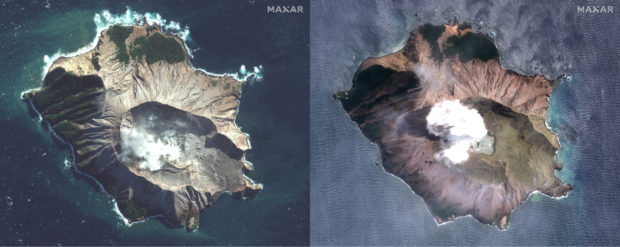WHAKATANE, New Zealand – New Zealand medical staff were continuing to work around the clock Thursday treating severely burned survivors of a volcanic eruption as police announced two more victims had died in hospitals, bringing the death toll to 16.

In this combo made from two satellite images taken May 12, 2019, left, and Dec. 11, 2019, right, by Maxar Technologies steam rises from the volcano on White Island off the coast of Whakatane, New Zealand. The White Island volcano vented more steam and mud Wednesday, Dec. 11, 2019, in an increase of geothermal activity that again delayed the recovery of victims’ bodies from a deadly eruption two days ago. (Satellite image ©2019 Maxar Technologies via AP)
The enormity of the task facing doctors in burn units around the country became clear when Dr. Peter Watson, a chief medical officer, said at a press conference that they had needed to order extra skin from American skin banks.
Watson said staff anticipated needing an extra 120 square meters (1,300 square feet) of skin for grafts for patients. Most of those who survived the eruption at White Island on Monday suffered burns, and 28 patients remain hospitalized, including 23 in critical condition.
The volcano has continued venting steam and mud, delaying plans by authorities to recover the bodies of victims from the volcano site. Authorities believe there are eight bodies that remain on the island.
The volcanic tremors on the island have intensified to a level not seen since an eruption in 2016, the GeoNet seismic monitoring agency said. It said shallow magma within the volcano appeared to be driving the increased activity. The volcano is about 50 kilometers (30 miles) off New Zealand’s North Island.
Meanwhile, Australia was sending a military plane to bring some of the Australians injured in the eruption to Australia for specialist medical care.
Authorities expected to transport 10 injured patients to New South Wales and Victoria states, beginning Thursday.
Monday’s eruption sent a tower of steam and ash an estimated 12,000 feet (3,660 meters) into the air.
Police believe 47 visitors were on the island at the time of the eruption, 24 of them Australian, nine Americans, five New Zealanders and others from Germany, Britain, China and Malaysia. Many were passengers aboard the Royal Caribbean cruise ship Ovation of the Seas.
In the town touted as the gateway to White Island, the volcano has an almost mystical significance, its regular puffing a feature of the landscape. Whether the island, also known by its Maori name Whakaari, will ever host tourists again remains uncertain.
Many people were questioning why tourists were allowed to visit the island after seismic monitoring experts raised the volcano’s alert level last month.
The island had been mined for sulfur until a 1914 accident in which at least 10 people were killed, and a landslide destroyed the miners’ village and the mine itself. The island became a private scenic reserve in 1953.
Daily tours allow more than 10,000 people to visit every year.